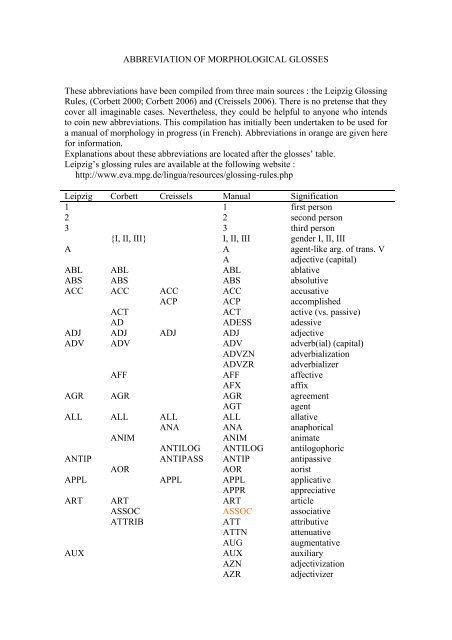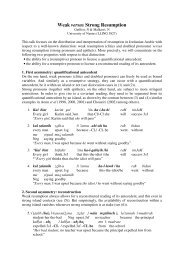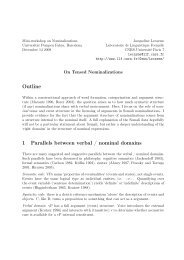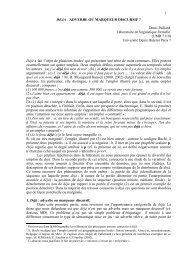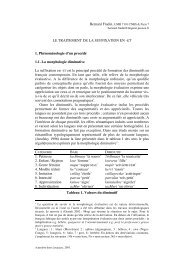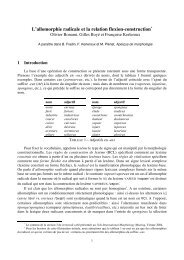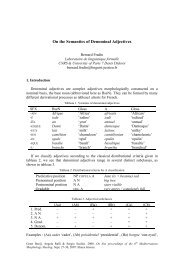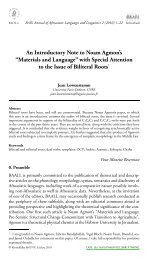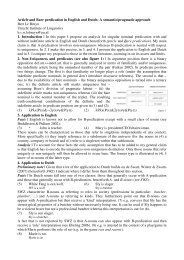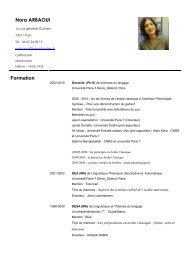the Leipzig Glossing Rule - CNRS
the Leipzig Glossing Rule - CNRS
the Leipzig Glossing Rule - CNRS
Create successful ePaper yourself
Turn your PDF publications into a flip-book with our unique Google optimized e-Paper software.
ABBREVIATION OF MORPHOLOGICAL GLOSSES<br />
These abbreviations have been compiled from three main sources : <strong>the</strong> <strong>Leipzig</strong> <strong>Glossing</strong><br />
<strong>Rule</strong>s, (Corbett 2000; Corbett 2006) and (Creissels 2006). There is no pretense that <strong>the</strong>y<br />
cover all imaginable cases. Never<strong>the</strong>less, <strong>the</strong>y could be helpful to anyone who intends<br />
to coin new abbreviations. This compilation has initially been undertaken to be used for<br />
a manual of morphology in progress (in French). Abbreviations in orange are given here<br />
for information.<br />
Explanations about <strong>the</strong>se abbreviations are located after <strong>the</strong> glosses’ table.<br />
<strong>Leipzig</strong>’s glossing rules are available at <strong>the</strong> following website :<br />
http://www.eva.mpg.de/lingua/resources/glossing-rules.php<br />
<strong>Leipzig</strong> Corbett Creissels Manual Signification<br />
1 1 first person<br />
2 2 second person<br />
3 3 third person<br />
{I, II, III} I, II, III gender I, II, III<br />
A A agent-like arg. of trans. V<br />
A adjective (capital)<br />
ABL ABL ABL ablative<br />
ABS ABS ABS absolutive<br />
ACC ACC ACC ACC accusative<br />
ACP ACP accomplished<br />
ACT ACT active (vs. passive)<br />
AD ADESS adessive<br />
ADJ ADJ ADJ ADJ adjective<br />
ADV ADV ADV adverb(ial) (capital)<br />
ADVZN adverbialization<br />
ADVZR adverbializer<br />
AFF AFF affective<br />
AFX affix<br />
AGR AGR AGR agreement<br />
AGT agent<br />
ALL ALL ALL ALL allative<br />
ANA ANA anaphorical<br />
ANIM ANIM animate<br />
ANTILOG ANTILOG antilogophoric<br />
ANTIP ANTIPASS ANTIP antipassive<br />
AOR AOR aorist<br />
APPL APPL APPL applicative<br />
APPR appreciative<br />
ART ART ART article<br />
ASSOC ASSOC associative<br />
ATTRIB ATT attributive<br />
ATTN attenuative<br />
AUG augmentative<br />
AUX AUX auxiliary<br />
AZN adjectivization<br />
AZR adjectivizer
Morphological abbreviations<br />
BEN BENEF BENEF BEN benefactive<br />
C consonant<br />
CAR caritative<br />
CARD cardinal (number)<br />
CAUS CAUS causative<br />
CFX circumfix<br />
CIRC CIRC circumstantial form of <strong>the</strong> V<br />
CIRCESS circumessive<br />
CIRCLAT circumlative<br />
CL CL nominal class<br />
CLF CLF CLAS CLF classifier<br />
CMLT cumulative<br />
CNT countable<br />
COLL collective<br />
COM COM COMIT COM comitative<br />
COMN COMN common gender<br />
COMP COMP complementizer<br />
COMPAR comparative<br />
COMPL COMPL completive<br />
COND COND conditional<br />
CONJ CONJ conjonction<br />
CONN CONN connective<br />
CONT CONT contessive<br />
COP COP copule<br />
CSTR CSTR noun’s construct form<br />
CVB CVB CONV CVB converb<br />
DAT DAT DAT dative<br />
D{1,2,3} D{PER} dative object index ‘D2PL’<br />
DECAUS DECAUS decausative<br />
DECL DECL DECL declarative<br />
DEF DEF DEF definite<br />
DELAT delative<br />
DEM DEM demonstrative<br />
DET DET determinant<br />
DIM DIM diminutive<br />
DIR DIR directionnel<br />
DIR DIR direct<br />
DISJ DISJ disjoined<br />
DIST DIST DIST distal<br />
DISTR DISTR distributive<br />
DLMT delimitative<br />
DU DU DU dual<br />
DUR DUR durative<br />
ELAT elative<br />
ERG ERG ERG ERG ergative<br />
ESM ESM epistemic status marker<br />
MOD ESS essif (case)<br />
EVID EVID evidential<br />
EXCL EXCL EXCL exclusive<br />
EXH exhibitive (numerals)
Morphological abbreviations<br />
EZF ezafe<br />
F F F(EM) F feminine<br />
FIG figure (vs. ground)<br />
FIN FIN final<br />
FLX flexive (inflectional affix)<br />
FOC FOC FOC FOC focus<br />
FOCO FOCO focalisation of object argt.<br />
FOCS FOCS focalisation of subject argt.<br />
FOCX FOCX focalisation of oblique argt<br />
FRAC fractionnal (numeral)<br />
FUT FUT FUT FUT future<br />
FVT tense verbal inflection<br />
GER GRD gerund<br />
GEN GEN GEN GEN genitive<br />
GER gender<br />
GRND ground (vs. figure)<br />
HAB HAB habitual<br />
HOL holistic<br />
HON HON (respect) honorific<br />
HHON (humile) honorific<br />
HORT HORT hortative<br />
HUM HUM human<br />
HYP HYP hypo<strong>the</strong>tical<br />
HYPC hypocoristic<br />
IDEO IDEO ideophone<br />
IFX infix<br />
ILL ILL ILL illative<br />
IMP IMP IMPER IMP imperative<br />
IMPARF IMPF imperfect<br />
INALIEN INALIEN inalienable<br />
INAN INAN inanimate<br />
INCH inchoative<br />
INCL INCL INCL inclusive<br />
IND IND IND indicative<br />
INDF INDF INDEF INDF indefinite<br />
INESS INESS INESS inessive<br />
INF INF INF infinitive<br />
INS INS INSTR INS instrumental<br />
INTENS INTENS intensifieur<br />
INTER INTER interrogative<br />
INTER INTER ‘between’ (spatial)<br />
INTR INTR INTR intransitive<br />
INV INV inverse<br />
IPFV IPFV IPFV imperfective<br />
IRR IRR irrealis<br />
JUSS jussive<br />
JONCT LNK linker<br />
LOC LOC LOC LOC locative<br />
LOG LOG logophoric<br />
M M M(ASC) M masculine
Morphological abbreviations<br />
MEL meliorative<br />
MOY MID middle voice<br />
MNS means (semantic role)<br />
MODE (unspecified) mood<br />
MSD masdar<br />
MULT multiplicative<br />
N noun (capital)<br />
N- N_ non- (e.g. N_PST nonpast)<br />
INACP NACP unaccomplished<br />
NARR past (tense) narrative<br />
NEG NEG NEG NEG negation, negative<br />
N N N(EU) NEU neuter<br />
VNF NFN non-finite verbal form<br />
NOBV NOBV non-obviative<br />
NOM NOM NOM NOM nominative<br />
NPR proper noun<br />
NUM numeral<br />
NZN nominalization<br />
NMLZ NZR nominalizer<br />
O{1,2,3}{S,P} O{PER}{NB} object’s index e.g. ‘O1SG’<br />
OBJ OBJ OBJ object<br />
OBL OBL OBL OBL oblique<br />
OBV OBV obviative<br />
OPT OPT OPT optative<br />
ORD ordinal (numeral)<br />
P P patient-like arg. of trans. V<br />
PREP P preposition<br />
PARTF PARTF partitive<br />
PASS PASS passive<br />
PAT PAT patient<br />
PEJ pejorative<br />
PERS PERS personnal<br />
PFV PFV PERF PFV perfective (aspect)<br />
PFX prefix<br />
PL PL PL plural<br />
POL polite<br />
POS POS positive (polarity)<br />
POSS POSS POSS possessive<br />
POST POST postposition<br />
POSTESS postessive<br />
POT POT potential<br />
PRED PRED predicative<br />
PREP PREP preposition (capital)<br />
PRF PRF PARF PRF perfect<br />
PRO PRO personal pronoun<br />
PROG PROG PROG progressive<br />
PROH PROH prohibitive<br />
PROLAT prolative<br />
PROX PROX proximal<br />
PRS PRES PRES PRS present
Morphological abbreviations<br />
PRET PRT preterit<br />
PRV PREV PRV preverb<br />
PST PST PAS PST past<br />
PTCL PTCL particle<br />
PTCP PTCP PART PTCP ; P_ participle<br />
PT participle X e.g. ‘PRSPT’<br />
PURP PURP purposive<br />
Q Q Q question marker<br />
QM QM quantity marker<br />
QUOT QUOT quotative<br />
RECP RECIPR RECP reciprocal<br />
REDUP RED reduplication<br />
REFL REFL REFL REFL reflexive<br />
REL REL REL REL relative<br />
RES RES RES resultative<br />
RESP RESP mark of respect<br />
RFX interfix<br />
RLS RLS realis<br />
S S single arg. of intrans. V<br />
S sentence (capital)<br />
S{1,2,3}{S,P} S{PER}{NB} subject’s index e.g. ‘S2PL’<br />
SBJ SUBJ SBJ subject<br />
SBJF SBJF future subjunctive<br />
SBJP SBJP past subjunctive<br />
SBJV SBJ SBJV subjunctive<br />
SFX suffix<br />
SG SG SG SG singular<br />
SPRX speaker proximate<br />
SUB SUB ‘sub’ localisation<br />
SUB SUB subordination marker<br />
SUBDELAT subdelative (spatial)<br />
SUBESS subessive (spatial)<br />
SUBLAT sublative (spatial)<br />
SUPER superlative (degree)<br />
SUPESS SUPESS superessive (spatial)<br />
SUPLAT superlative (spatial)<br />
TAM TAM tense, aspect, mode<br />
TERM terminative<br />
TOP TOP topic<br />
TR TR transitive<br />
TRANS translative (become X)<br />
TRSLAT translative (across, kroz…)<br />
TRANS TRZN transitivization<br />
TRZR transitivizer<br />
UCNT uncountable<br />
V verb (capital)<br />
VOC VOC vocative<br />
VOIX VOX voice<br />
VZN verbalization<br />
VZR verbalizer
Table 1. List of abbreviations<br />
Comments<br />
Morphological abbreviations<br />
XCLM exclamative, exclamation<br />
A. Within glosses, abbreviations are in small caps; syntactic categories in <strong>the</strong> text are in<br />
capitals (A, N, etc.).<br />
B. Some abbreviations are exceedingly long. This is often <strong>the</strong> case with participles. We<br />
propose to abbreviate ‘participle’ by PT. In <strong>Leipzig</strong>’s style ‘passive present participle’<br />
becomes PASS_PRS_PT, but we allow <strong>the</strong> compact abbreviation PASSPRSPT.<br />
C. In order to help memorization and for coherence purposes, series have been<br />
constituted :<br />
— all affixes end with ‘fx’ e.g. afx, sfx, pfx, ifx, rfx, etc.<br />
— all category changing marks follow <strong>the</strong> model ‘zr’, where C indicates <strong>the</strong> output<br />
category e.g. NZR = nominalizing mark, AZR = adjectivizing mark, etc.<br />
— all long abbreviations ending in ‘PT’ encode participles.<br />
D. In <strong>Leipzig</strong>’s notation some notions (infix, reduplication, etc.) are directly encoded<br />
within <strong>the</strong> form of <strong>the</strong> gloss (cf. <strong>the</strong> use of ‘~’, ‘< >’, etc.). Never<strong>the</strong>less, an abbreviated<br />
form of <strong>the</strong>se notions can be helpful (i) when one wants to refer to <strong>the</strong> generic use of <strong>the</strong><br />
notion (e.g. to indicate that <strong>the</strong>re is an affix <strong>the</strong> function of which remains unknown),<br />
(ii) to name semantic rules associated to forms. For instance, <strong>the</strong> semantic rule<br />
associated with reduplication in a given language L might be formulated as: REDS(X) =<br />
‘|X| ≥ 2’.<br />
E. For languages marking agreement with subject or object in a cumulative way,<br />
Creissels’s notation, which amalgamates slots, seems to be <strong>the</strong> most compact and yet<br />
<strong>the</strong> simplest way to encode what is observed. Two cases have to be distinguished,<br />
depending on <strong>the</strong> language’s type:<br />
1. Function slot, person slot, number slot: S1SG = ‘subject, 1 rst person, singular’<br />
2. Function slot, person slot, (nominal) class slot (i.e. number): O3:1 = ‘object, 3 rd<br />
person, class 1 (= singular).<br />
F. For locative marking, we have adopted Kracht’s classification (Kracht 2002)(cf. table<br />
2) extending it slightly with various proposals (cf. Mel'čuk 1994; Haspelmath 1993).<br />
‘Coinitial’ denotes <strong>the</strong> place that a moving object (Figure) come from, and cofinal <strong>the</strong><br />
place where it ends.<br />
eng lat Stative Coinitial Cofinal<br />
in in inessive elative illative<br />
at ad adessive ablative allative<br />
on super superessive delative superlative<br />
under sub subessive subelative sublative<br />
behind post postessive postelative postlative<br />
across trans transessive translative<br />
around circum circumessive circumlative<br />
Tableau 2. After Kracht 2002.
Morphological abbreviations<br />
Abbreviation of languages<br />
Norm ISO 639-3, which is used by typologists and UNESCO, is <strong>the</strong> more recent one<br />
and covers over 6,900 languages : http://www.ethnologue.com/web.asp<br />
References<br />
Corbett Greville. 2006. Agreement. Cambridge: Cambridge University Press.<br />
Corbett Greville G. 2000. Number. Cambridge: Cambridge University Press.<br />
Creissels Denis. 2006. Syntaxe générale. Une introduction typologique 1. Catégories et<br />
constructions. Paris: Hermès / Lavoisier.<br />
Haspelmath Martin. 1993. A Grammar of Lezgian. Vol. 9, Mouton Grammar Library.<br />
Berlin / New York: Mouton de Gruyter.<br />
Kracht Marcus. 2002. "On <strong>the</strong> Semantics of Locatives". Linguistics and Philosphy<br />
25:157-232.<br />
Mel'čuk Igor A. 1994. Cours de morphologie générale. Deuxième partie: significations<br />
morphologiques. 5 vols. Vol. 2. Montréal: Presses de l'Université de Montréal -<br />
<strong>CNRS</strong> Editions.


